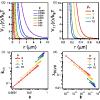当前位置:
X-MOL 学术
›
Phys. Rev. E
›
论文详情
Our official English website, www.x-mol.net, welcomes your
feedback! (Note: you will need to create a separate account there.)
Fragile-to-strong crossover, growing length scales, and dynamic heterogeneity in Wigner glasses
Physical Review E ( IF 2.2 ) Pub Date : 2020-03-17 , DOI: 10.1103/physreve.101.032605 Hyun Woo Cho , Mauro L. Mugnai , T. R. Kirkpatrick , D. Thirumalai
Physical Review E ( IF 2.2 ) Pub Date : 2020-03-17 , DOI: 10.1103/physreve.101.032605 Hyun Woo Cho , Mauro L. Mugnai , T. R. Kirkpatrick , D. Thirumalai

|
Colloidal particles, which are ubiquitous, have become ideal testing grounds for the structural glass transition theories. In these systems glassy behavior arises as the density of the particles is increased. Thus, soft colloidal particles with varying degree of softness capture diverse glass-forming properties, observed normally in molecular glasses. Brownian dynamics simulations for a binary mixture of micron-sized charged colloidal suspensions show that tuning the softness of the interaction potential, achievable by changing the monovalent salt concentration results in a continuous transition from fragile to strong behavior. Remarkably, this is found in a system where the well characterized interaction potential between the colloidal particles is isotropic. We also show that the predictions of the random first-order transition (RFOT) theory quantitatively describes the universal features such as the growing correlation length, with where , the analog of the Kauzmann temperature, depends on the salt concentration. As anticipated by the RFOT predictions, we establish a causal relationship between the growing correlation length and a steep increase in the relaxation time and dynamic heterogeneity as the system is compressed. The broad range of fragility observed in Wigner glasses is used to draw analogies with molecular and polymer glasses. The large variations in the fragility are normally found only when the temperature dependence of the viscosity is examined for a large class of diverse glass-forming materials. In sharp contrast, this is vividly illustrated in a single system that can be experimentally probed. Our work also shows that the RFOT predictions are accurate in describing the dynamics over the entire density range, regardless of the fragility of the glasses.
中文翻译:

Wigner眼镜的脆弱性到强烈的交叉,不断增长的长度尺度和动态异质性
胶体粒子无处不在,已成为结构玻璃化转变理论的理想测试基础。在这些系统中,随着颗粒密度的增加,出现玻璃态行为。因此,通常在分子玻璃中观察到,具有不同柔软度的软胶体颗粒捕获了多种玻璃形成特性。对微米级带电胶体悬浮液的二元混合物进行的布朗动力学模拟表明,通过改变单价盐浓度可实现调节相互作用势的软度,从而导致从脆弱行为向强行为的连续转变。值得注意的是,这是在胶体颗粒之间具有良好特征的相互作用势是各向同性的系统中发现的。 与 哪里 Kauzmann温度的类似物取决于盐浓度。正如RFOT预测所预期的,我们在增长的相关长度与系统压缩时的松弛时间和动态异质性的急剧增加之间建立因果关系。在维格纳玻璃中观察到的广泛的脆性被用来与分子玻璃和聚合物玻璃进行类比。通常仅当针对大量不同种类的玻璃形成材料检查粘度的温度依赖性时,才发现脆性的大变化。与之形成鲜明对比的是,这可以在一个可以进行实验探测的单一系统中生动地说明。我们的工作还表明,RFOT预测在描述整个密度范围内的动力学方面是准确的,而与眼镜的脆弱性无关。
更新日期:2020-03-19
中文翻译:

Wigner眼镜的脆弱性到强烈的交叉,不断增长的长度尺度和动态异质性
胶体粒子无处不在,已成为结构玻璃化转变理论的理想测试基础。在这些系统中,随着颗粒密度的增加,出现玻璃态行为。因此,通常在分子玻璃中观察到,具有不同柔软度的软胶体颗粒捕获了多种玻璃形成特性。对微米级带电胶体悬浮液的二元混合物进行的布朗动力学模拟表明,通过改变单价盐浓度可实现调节相互作用势的软度,从而导致从脆弱行为向强行为的连续转变。值得注意的是,这是在胶体颗粒之间具有良好特征的相互作用势是各向同性的系统中发现的。 与 哪里 Kauzmann温度的类似物取决于盐浓度。正如RFOT预测所预期的,我们在增长的相关长度与系统压缩时的松弛时间和动态异质性的急剧增加之间建立因果关系。在维格纳玻璃中观察到的广泛的脆性被用来与分子玻璃和聚合物玻璃进行类比。通常仅当针对大量不同种类的玻璃形成材料检查粘度的温度依赖性时,才发现脆性的大变化。与之形成鲜明对比的是,这可以在一个可以进行实验探测的单一系统中生动地说明。我们的工作还表明,RFOT预测在描述整个密度范围内的动力学方面是准确的,而与眼镜的脆弱性无关。











































 京公网安备 11010802027423号
京公网安备 11010802027423号